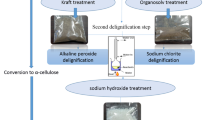Abstract
The structural degradation of cellulose fibre from hemp (Cannabis Sativa L.) by a ball-milling process and the recrystallization behavior of the product were studied. A linear increase in the Brunauer–Emmett–Teller specific surface area was observed; indicating the fibre bundles were being crushed and disrupted to single fibres, which was confirmed by SEM. An increase in the milling duration gradually destroyed the crystalline structure of the cellulose fibres, observed by a reduction of the 002 plane intensity in wide angle X-ray scattering measurements. The crystalline order index calculated from the area ratio of the 002 to the 021, 10\(\overline{1}\) and 002 planes was decreased from 65 to 36 after milling for 330 min. Subsequently the lower thermal stability of ball-milled fibre was observed from a decrease in the temperature at the maximum mass loss rate using thermogravimetry. An increase in solvent polarity, solvent-fibre ratio, agitation speed and drying rate resulted in the rearrangement of ball-milled cellulose crystalline structure to a greater order. Moreover, an increase in the BET specific surface area and the amorphous fraction improved the scouring efficiency of the ball-milled cellulose using the pectate lyase enzyme (EC. 4.2.2.2).
Similar content being viewed by others
References
Ago M., Endo T., Hirotsu T. (2004) Crystalline transformation of native cellulose from cellulose I to cellulose Ii polymorph by a ball-milling method with a specific amount of water. Cellulose 11: 163–167
Altunina L.K., Gossen L.P., Tikhonova L.D., Yarmukhametova E.G. (2002) Structural Changes in Cellulose-Containing Materials in the Course of Mechnical Activation. Macromol. Chem. Polymer. Mat. 75(1): 166–167
Asko V. (1971) Heterogeneous acid hydrolysis of cellulose. Part V the effect of ball-milling on the hydrolysability. Paperi ja Puu 53(7): 397–400, 402–408
Bang Y.H., Lee S., Park J.B., Cho H.H. (1999) Effect of coagulation conditions on fine structure of regenerated cellulose films made from cellulose/N-Methylmorpholine-N-Oxide/H2O systems. J. Appl. Polymer Sci. 73: 2681–2690
Bertran M.S., Dale B.E. (1985) Enzymeatic hydrolysis and recrystallization behavior of initially amorphous cellulose. Biotechnol. Bioeng. 27: 177–181
Doelker E., Gurny R. (1987) Degrees of crystallinity and polymerization of modified cellulose powders for direct tableting. Powder Technol. 52: 207–213
Furcht P.W., Silla H. (1990) Comparison of simultaneous milling and enzymetic hydrolysis of cellulose in ball mill and attrition mill reactors. Biotechnol. Bioeng. 35: 630–645
Garcia-Jaldon C., Dupeyre D., Vignon M.R. (1998) Fibres from semi-retted hemp bundles by steam explosion treatment. Biomass Bioenergy 14(3): 251–260
Howsmon J.A., Marchessault R.H. (1959) The ball-milling of cellulose fibres and recrystallization effects. J. Appl. Polymer Sci. 1(3): 313–322
Iyer P.B., Sreenivasan S., Chidambareswaran P.K., Patil N.B. (1984) Crystallization of amorphous cellulose. Textile Res. J. 54(11): 732–735
Iyer P.B., Sreenivasan S., Chidambareswaran P.K., Patil N.B. (1986) Recrystallization of cellulose. Textile Res. J. 56(8): 509–11
Kothari S.H., Kumar V., Banker G.S. (2002) Comparative evaluations of powder and mechanical properties of low crystallinity cellulose, microcrystalline celluloses and powder celluloses. Int. J. Pharm. 232: 69–80
Kwan C.C., Ghadiri M., Dimitris G.P., Bentham A.C. (2003) The effects of operating conditions on the milling of microcrystalline cellulose. Chem. Eng. Technol. 26(2): 185–190
Liang X.H., Gu L.Z., Ding E.Y. (1993) Recrystallization behavior of cellulose and lignocellulose from Pinus massoniana. Wood Sci. Technol. 27(6): 461–467
Majdanac L.D., Teodorovic M.J. (1987) The influence of supermolecular structure on the kinetics of thermal decompopsition of cellulose. Acta Polymerica 38(12): 661–666
Marx-Figini M., Victor-Figini R. (1995) Studies on the mechanical degradation of cellulose. Die Angewandte Makromolekulare Chemie 224: 179–189
Ouajai S., Hodzic A., Shanks R.A. (2004) Morphology and grafting modification of natural cellulose fibre. J. Appl. Polymer Sci. 94: 2456–2465
Ouajai S., Shanks R.A. (2005) Morphology and structure of bioscouring hemp fibre. Macromol. Biosci. 5: 124–134
Pitchumani R., Zhupanska O., Meesters G.M.H., Scarlett B. (2004) Measurement and characterization of particle strength using a new robotic compression tester. Powder Technol. 143–144: 56–64
Qui W., Endo T., Hirotsu T. (2004) Interfacial interactions of a novel mechanochemical composite of cellulose with maleated polypropylene. J. Appl. Polymer Sci. 94: 1326–1335
Ramlakhan M., Yu Wu C., Watano S., N. Dave R., Pfeffer R. (2000) Dry particle coating using magnetically assisted impaction coating: Modification of surface properties and optimization of system and operating parameters. Powder Technol. 112: 137–148
Scheirs J., Camino G., Tumiatti W. (2001) Overview of water evolution during the thermal degradation of cellulose. Eur. Polymer J. 37: 933–942
Segal L., Creely J.J., Martin Jr. A.E., Conrad C.M. (1959) An empirical method for estimating the degree of crystallinity of native cellulose using the X-ray diffractometer. Textile Res. J. 29: 786–794
Tanaka F., Fukui N. (2004) The behavior of cellulose molecules in aqueous environment. Cellulose 11: 33–38
Vignon M.R., Dupeyre D., Garcia-Jaldon C. (1996) Morphological characterization of steam-exploded hemp fibers and their utilization in polypropylene-based composites. Bioresource Technol. 58(2): 203–215
Vinson K.D. 1988. Process for making expanded fibre. United State Patent Office. United State of America, The Buckeye Cellulose corporation.
Zografi G., Kontny M.J., Yang A.Y.S., Brenner G.S. (1984) Surface area and water vapor sorption of microcrystalline cellulose. Int. J. Pharm. 18(1984): 99–116
Acknowledgements
The authors gratefully thank King Mongkut’s Institute of Technology North Bangkok (KMITNB), Thailand for a PhD scholarship.
Author information
Authors and Affiliations
Corresponding author
Rights and permissions
About this article
Cite this article
Ouajai, S., Shanks, R. Solvent and enzyme induced recrystallization of mechanically degraded hemp cellulose. Cellulose 13, 31–44 (2006). https://doi.org/10.1007/s10570-005-9020-5
Received:
Accepted:
Published:
Issue Date:
DOI: https://doi.org/10.1007/s10570-005-9020-5




